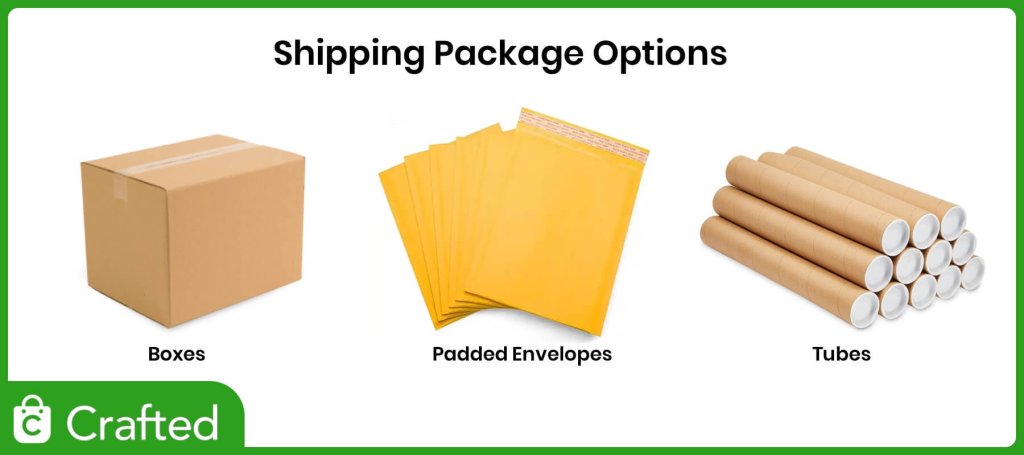You pour your heart and soul into creating unique and beautiful products that your customers will love. But when it comes to shipping those products, it can be easy to feel overwhelmed and unsure of how to proceed. Shipping may not be the most glamorous aspect of running an Etsy shop, but it’s a crucial one. From understanding shipping options and costs to effectively packaging and communicating with customers, there are a lot of factors to consider. In this article, we’ll share our top shipping tips for Etsy sellers, so you can ship your products with confidence and ease. So, let’s dive in!
Understanding Shipping Options
Shipping carriers
There are several common carriers to choose from, including: USPS, UPS, FedEx, and DHL. Each carrier has its own strengths and weaknesses, so it’s important to do your research and choose the one that best fits your needs. Factors to consider include shipping rates, delivery times, tracking capabilities, insurance options, and customer service.
USPS

Pros
- Typically offers lower rates compared to other carriers.
- Offers several shipping options, including First-Class, Priority, and Express Mail.
- Provides free packaging materials and free pick-up service for Priority and Express Mail.
- Delivers to PO boxes and military addresses.
Cons
- Delivery times can be inconsistent, especially during peak shipping periods.
- Tracking information can be limited.
UPS

Pros
- Offers several shipping options, including Ground, 2-Day Air, and Overnight.
- Provides comprehensive tracking and delivery confirmation.
- Offers convenient drop-off locations and pick-up service.
- Offers a variety of additional services, such as insurance, signature confirmation, and delivery to specific locations.
Cons
- Shipping rates can be higher than other carriers.
- Additional fees may apply for some services.
FedEx

Pros
- Offers several shipping options, including Ground, Express, and International shipping.
- Provides comprehensive tracking and delivery confirmation.
- Offers a variety of additional services, such as insurance, signature confirmation, and delivery to specific locations.
- Offers a money-back guarantee for some services.
Cons
- Shipping rates can be higher than other carriers.
- Some additional fees may apply.
DHL

Pros
- Offers international shipping services.
- Provides comprehensive tracking and delivery confirmation.
- Offers a variety of additional services, such as insurance, signature confirmation, and delivery to specific locations.
Cons
- Not as widely available as other carriers in some areas.
- Shipping rates can be higher than other carriers.
Common Shipping methods
Once you’ve chosen a carrier, you’ll need to decide on a shipping method. The most common shipping methods include First-Class Mail, Priority Mail, and Express Mail for USPS, and Ground, 2-Day Air, and Overnight for UPS and FedEx. Each method has its own variable delivery time and cost, so it’s important to choose the one that meets your customer’s needs and your budget.
Factors that Impact shipping costs
Shipping costs can vary greatly depending on several factors, such as the weight and size of your package, the distance it needs to travel, and the shipping method you choose.
- Weight and size of your package: The weight and size of your package are key factors in determining the shipping cost. Generally, the larger and heavier your package, the more it will cost to ship. This is because carriers charge based on dimensional weight (the amount of space the package takes up) or actual weight, whichever is greater. It’s important to accurately measure and weigh your packages to avoid under- or overestimating shipping costs.
- Distance it needs to travel: The distance that your package needs to travel is another important factor in determining shipping costs. Carriers may charge more for longer distances or for packages traveling to more remote areas. It’s important to keep in mind the destination of your package when estimating shipping costs.
- Shipping method you choose: The shipping method you choose can also impact shipping costs. Express shipping methods, for example, are generally more expensive than ground shipping methods. However, faster shipping times may be necessary for certain products or customer expectations. Consider the needs of your customers and the nature of your products when choosing a shipping method.
- Shipping supplies: The cost of shipping supplies, such as boxes, envelopes, and tape, can also impact shipping costs. Some carriers offer free shipping supplies, while others may charge for them. Consider the cost of shipping supplies when estimating overall shipping costs.
- Insurance: Adding insurance to your shipments can also impact shipping costs. This may be especially important for high-value or fragile items. Be sure to research insurance options and costs for each carrier to determine whether it’s worth the added expense.
- Special services: Finally, any special services you may require, such as signature confirmation or special handling, can impact shipping costs. These services may be necessary for certain types of products or to meet specific customer needs. Be sure to research the costs of these services to determine whether they’re necessary and feasible for your business.
How to choose the right shipping option
Choosing the right shipping option can be tricky, but there are a few things you can do to make the process easier. First, consider your customer’s needs and preferences. Do they need their order to arrive quickly or are they willing to wait a little longer for a lower shipping cost? Second, consider your own needs and budget. Are you able to absorb the cost of shipping, or do you need to pass it on to your customer? Finally, don’t be afraid to experiment with different shipping options until you find the one that works best for you and your customers.s
Packaging and Labeling
Types of packaging
There are several types of packaging to choose from, depending on the nature of your product and its fragility. Some common types include boxes, padded envelopes, and tubes. Consider the size and weight of your product, as well as its fragility, when choosing a packaging type.
Boxes
- Pros: Boxes are versatile and come in a range of sizes, making them suitable for a variety of products. They also provide good protection for fragile items and can be customized with your branding.
- Cons: Boxes can be heavy and bulky, which can increase shipping costs. They also require additional packaging materials, such as packing peanuts or bubble wrap, to protect items during shipping.
Padded Envelopes
- Pros: Padded envelopes are lightweight and easy to handle, which can help reduce shipping costs. They also offer some protection for small or lightweight items.
- Cons: Padded envelopes are not suitable for larger or fragile items and may not offer sufficient protection during shipping.
Tube
- Pros: Tubes are ideal for shipping long, narrow items such as posters or prints. They are also lightweight and can help reduce shipping costs.
- Cons: Tubes do not offer much protection for items that are fragile or require additional padding. They may also be difficult to handle and store.

Packaging materials
In addition to the type of packaging, you’ll also need to consider the materials used for packaging. Some common packaging materials include bubble wrap, packing peanuts, and tissue paper. You’ll also want to ensure that your packaging materials are eco-friendly and sustainable, as this is becoming increasingly important to many consumers.
Here’s a few ways you can take a sustainable approach to packaging, while also saving some money:
- Buy in bulk: If you plan to use a lot of packaging materials, consider buying in bulk to save money. Many suppliers offer discounts for larger orders.
- Use recycled materials: Using recycled materials for packaging not only helps the environment, but can also be cost-effective. Look for suppliers who offer recycled packaging materials or repurpose materials you already have on hand, such as newspapers or cardboard boxes.
- Partner with eco-friendly suppliers: Some suppliers specialize in eco-friendly packaging materials and may offer discounts for bulk orders or long-term partnerships.
Labeling requirements
Proper labeling is crucial for a smooth and efficient shipping process. Make sure to include the correct shipping address, as well as your return address, on each package. You may also need to include additional information, such as customs information for international shipments.
Minimum requirements for labeling packages when shipping within the United States:
- Delivery address
- Return address
- Proper postage or shipping label
It’s important to ensure that all required information is clearly and legibly marked on each package. Additionally, be sure to check for any specific labeling requirements for hazardous materials, if applicable.
Tips for effective packaging and labeling
Here are some tips to ensure that your packaging and labeling are effective and efficient:
- Use sturdy packaging materials to protect your products during transit.
- Ensure that your packaging is appropriately sized to avoid excessive packaging materials and shipping costs.
- Consider eco-friendly packaging materials to appeal to environmentally-conscious customers.
- Consider double-boxing fragile items, with the item wrapped in cushioning material and then placed inside a second, larger box with additional cushioning material.
- Choose the right cushioning material based on the fragility and weight of the item. Options include bubble wrap, packing peanuts, air pillows, or foam inserts.
- Wrap each item individually to prevent scratching or damage from contact with other items in the package.
- Label the package clearly with the shipping address, return address, and any handling instructions.
- Consider adding a “Fragile” or “Handle with Care” label or sticker to alert handlers to the delicate contents of the package.
- Avoid over-packing the box, as this can increase the weight and cost of shipping. Find the right balance between protecting the item and keeping the package lightweight.
- Include a personalized note or thank you card with each package to create a positive customer experience.
Shipping Rates and Costs
Comparison of carrier rates
When it comes to comparing shipping rates, it’s important to consider the specific needs of your business and your customers. Here’s a breakdown of some common rates for USPS, UPS, and FedEx (as of April 2023):
USPS
- First-Class Mail: Starts at $0.58 for letters, $4.09 for packages (up to 16 oz)
- Priority Mail: Starts at $7.95 for packages (up to 1 lb), $10.25 for flat rate envelopes
- Express Mail: Starts at $27.35 for packages (up to 0.5 lb)
UPS
- Ground: Starts at $8.25 for packages (up to 1 lb)
- 2nd Day Air: Starts at $20.85 for packages (up to 1 lb)
- Next Day Air: Starts at $29.65 for packages (up to 1 lb)
FedEx
- Ground: Starts at $8.45 for packages (up to 1 lb)
- 2Day: Starts at $22.70 for packages (up to 1 lb)
- Overnight: Starts at $36.20 for packages (up to 1 lb)
These rates are subject to change based on package weight, dimensions, destination, and other factors. Be sure to research and compare rates for your specific shipping needs.
How to calculate shipping costs
Calculating shipping costs can be a complex process, but most carriers offer online calculators or rate charts to make it easier. To calculate shipping costs, you’ll generally need to provide information such as package weight and dimensions, destination, shipping method, and any additional services required.
Let’s say you’re shipping a 3 lb package from New York, NY to Los Angeles, CA using USPS Priority Mail. Here’s how you can calculate the shipping cost:
- Measure and weigh the package: Let’s say the package measures 12″ x 8″ x 6″ and weighs 3 lbs.
- Determine the shipping method: In this case, we’re using USPS Priority Mail.
- Visit the USPS Postage Price Calculator: Go to https://postcalc.usps.com/ to access the USPS calculator.
- Enter the package information: Enter the package weight and dimensions, as well as the shipping method and destination.
- Calculate the shipping cost: Based on the information entered, the shipping cost for this package would be $11.35.
Here are some links to popular carrier calculators:
- USPS Postage Price Calculator: https://postcalc.usps.com/
- UPS Shipping Calculator: https://www.ups.com/ship/prices/package
- FedEx Rate Finder: https://www.fedex.com/en-us/shipping/rates.html
International Shipping
Expanding your Etsy shop to international markets can be a great way to grow your business and reach a wider audience. However, international shipping comes with its own set of challenges and considerations. Here’s what you need to know to successfully navigate international shipping:
Challenges of international shipping
When shipping internationally, it’s important to carefully research and consider the regulations and requirements for each country you plan to ship to. For example, some countries may have restrictions on certain products, such as food, plants, or textiles. Others may require specific documentation, such as customs forms or commercial invoices. Additionally, many countries charge customs duties and taxes on imported goods, which can vary widely depending on the country and the value of the goods.
To ensure that you’re in compliance with these regulations, be sure to research the specific requirements for each country you plan to ship to. For example, if you’re shipping textiles to France, you’ll need to ensure that your products meet French standards and regulations for textile imports, if its being shipped to Brazil you’ll have separate requirements you’ll need to satisfy.
In addition, you’ll also need to complete customs forms and provide detailed information about the contents of each package. For example, you may need to provide a detailed description of the materials used to make a necklace, or provide documentation showing that your products meet specific safety or environmental standards.
To ensure that you’re properly handling customs, consider using a customs broker or consulting with a shipping expert. These professionals can help you navigate the complex customs process and ensure that your packages are processed quickly and without issue. By being aware of the regulations and requirements involved in international shipping, and seeking expert advice when needed, you can successfully expand your Etsy shop to international markets and reach a wider audience.
Tracking and Communication
Tracking is an essential tool for keeping your customers informed about the status of their orders. With tracking information, customers can easily see when their package is expected to arrive and track its progress along the way. Providing tracking information can also help build trust with your customers and reduce the likelihood of disputes or issues with delivery.
How to provide tracking information:
Most shipping carriers provide tracking information as part of their shipping services. Be sure to provide this information to your customers as soon as it becomes available. You can do this through your Etsy shop by updating the order status or sending a message to the customer with the tracking information.
Tips for effective communication with customers:
- Be proactive: Reach out to your customers as soon as possible to let them know when their order has shipped and provide any relevant tracking information.
- Be responsive: If a customer reaches out with a question or concern, respond promptly and professionally.
- Be transparent: If there are any issues with shipping or delivery, be honest and upfront with your customers about the situation and work with them to find a solution.
Returns and Exchanges
When a customer wants to return or exchange a product, it’s important to have clear policies and procedures in place. This includes outlining the process for initiating a return or exchange, the timeframe for returns, and any conditions that must be met for a return or exchange to be accepted. In most cases the policies here you setup when you created your store, however, its good to revisit them from time to time.
Your Etsy Shop page
Your return and exchange policies should be clearly outlined on your Etsy shop page and in your order confirmations. This helps set expectations for your customers and ensures that they understand your policies before making a purchase. Your policies should cover details such as the timeframe for returns or exchanges, the condition the product must be in, and who is responsible for paying for return shipping.
Tips for minimizing returns and exchanges
While returns and exchanges are inevitable in any business, there are steps you can take to minimize them. Here are some tips:
- Provide accurate product descriptions and photos: By providing detailed and accurate product descriptions and photos, you can help ensure that your customers receive the product they were expecting.
- Offer sizing and customization options: By offering sizing and customization options, you can help ensure that your customers receive a product that fits their needs.
- Respond promptly to customer inquiries: By responding promptly and professionally to customer inquiries, you can help prevent misunderstandings and reduce the likelihood of returns or exchanges.
- Use high-quality materials: By using high-quality materials in your products, you can help ensure that they are durable and long-lasting, reducing the likelihood of returns or exchanges.
With these strategies in your toolkit, you’re ready to confidently manage shipping, returns, and exchanges for your Etsy shop. To recap:
- Understand the different shipping options available, as well as the factors that impact shipping costs, can help you choose the right carrier and shipping method for your business.
- Proper packaging and labeling can help ensure that your products arrive safely and on time.
- International shipping requires careful research and attention to regulations and customs requirements.
- Providing tracking information and effective communication with your customers is crucial for building trust and reducing the likelihood of disputes or issues with delivery.
- Having clear policies and procedures in place for returns and exchanges, as well as taking steps to minimize them, can help ensure a positive experience for your customers.
As you implement these tactics in your Etsy shop, keep in mind that shipping and returns can be a complex and ever-changing landscape and you’ll most likely need to revisit things as your shop grows.



